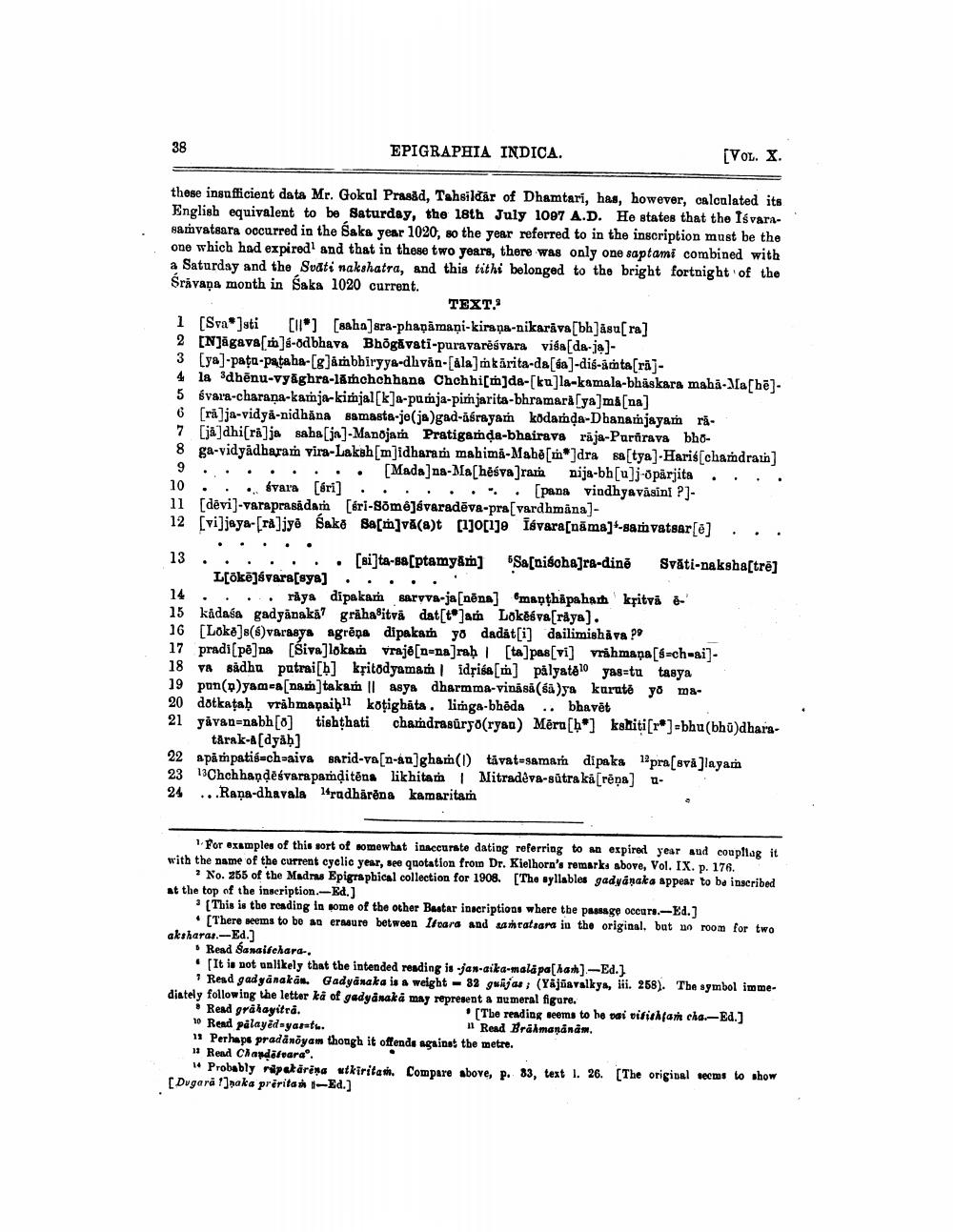________________
EPIGRAPHIA INDICA.
(VOL. X.
these insufficient data Mr. Gokul Prasid, Tahsildar of Dhamtari, has, however, calculated its English equivalent to be Saturday, the 18th July 1097 A.D. He states that the Isvarasamvatsara occurred in the Saks year 1020, so the year referred to in the inscription must be the one which had expired and that in these two years, there was only one saptami combined with a Saturday and the Svati nakshatra, and this tithi belonged to the bright fortnight of the Sravana month in Saka 1020 current.
TEXT. 1 (Sva®]sti [ll] [saha]ara-phaņāmaņi-kirana-nikaräva[bh]ásu[ra] 2 [NJägave[u]s-odbhava Bhögåvati-puravarėśvara visa(da-ja)3 [ya)-paça-pataha-[g]ambhiryya-dhvăn-[ala]ókärita-da[fa]-dis-årta [ra]4 la 3dhēnu-vy Ighra-lamchchhana Chchhi[m]da-[ku]la-kamala-bhaskara maha Mashēl. 5 svara-charana-kanja-kimjal[k]a-pumja-pimjarita-bhramara[ya]ma[na] 6 [ra]ja-vidya-nidhāna samasta-je(ja)gad-aśrayam kodamda-Dhanamjayam rá. 7 [ja]dhi[ra]ja saha (ja) - Mandjar Pratigamda-bhairava raja-Purirava bho8 ga-vidyadharam vira-Laksh[m]idharan mahima-Mabe[m]dra satyal-Haris[chandrain]
. . . . . . .. (Mada]na-Mashēśva]ram nija-bh[u]j-oparjita . . . . 10 . . svara (sri] . . . . . .. . pana vindhyavasini ?]11 [dēvi)-varaprasadam (éri-Sõmêjávaradēva-pra vardhmana)12 [vi]jaya [ra]jyė Sako Ba[m]vá(a)t [1]0[1]e Isvara[nāma]'-samvatsar[e] ...
13 .... .. [si]ta-88[ptamy.m] Sasoischajra-dině Svāti-nakshastrē]
L[okējśvara[sys] . . . . . 14 ... riya dipakam saryva-ja[nēna] mapthapahah kritvå e15 kadasa gadyanaka? grähaʻitvå dat[t]a Lokčiva[rdys). 16 [Loke)s(varasys agrépa dipakam yo dadat[i] dailimishiva Po 17 pradi(pē]na (Śiva]lokam vrajé[n=na]rah | [ta]pas[vi] vrähmaņa (=ch-ai). 18 va sådhu putrai[b] křitodyamam idpisa[m] pályatělo yag=tu tasya 19 pun(o)yam-a(nat)takam || asya dharmma-vináså(sa)ya karutė yo ma20 dotkataḥ vrahmapaih koţighata, linga-bhods .. bhavēt 21 yavan-nabh[0] tishthati chamdrasuryo(ryan) Mēra[ho] kahiti[r]=bhu(bhū)dhara
tárak-A[dyah] 22 apāṁpatis-ch-aiva sarid-va[n-ad]ghar(1) tävat-samam dipaka 12 pra[svá]layam 23 13Chchhandesvarapanditēna likhitar | Mitradeva-sūtra ka[rēņa] - 24 ... Raņa-dhavala radhärēna kamaritam
For examples of this sort of somewhat inaccurate dating referring to an expired year and coupling it with the name of the current cyclic year, see quotation from Dr. Kielhorn's remarks above, Vol. IX. p. 176.
* No. 255 of the Madrus Epigraphical collection for 1908. [The syllables gadyanaka appear to be inscribed at the top of the inscription. -Ed.)
. (This is the reading in some of the other Bastar inscriptions where the passage occurs-Ed.)
(There seems to be an erasure between Ittara and sanatsana in the original. but no room for two aksharas.-Ed.]
Read Sancifchara-. • [It is not unlikely that the intended reading is -jan-aika-malapa[hash] -Ed.]
Read gadganakan. Gadyanaka is a weight - 82 guijar ; (Yajñavalkya, iii. 268). The symbol immediately following the letter kå of gadyanaka may represent a numeral figure. . Read grähayitra.
[The reading seems to he dai difisha cha.-Ed.) 10 Read pålayed-yarat.
1 Read Brahmananas. 11 Perhaps pradánõyam though it offends against the metre. 1 Read Chandöfrara.
Probably patarina wtkiritans. Compare above, p. 83, text I. 26. [The original seems to show [Dugará 1]naka pröritas -Ed.)




